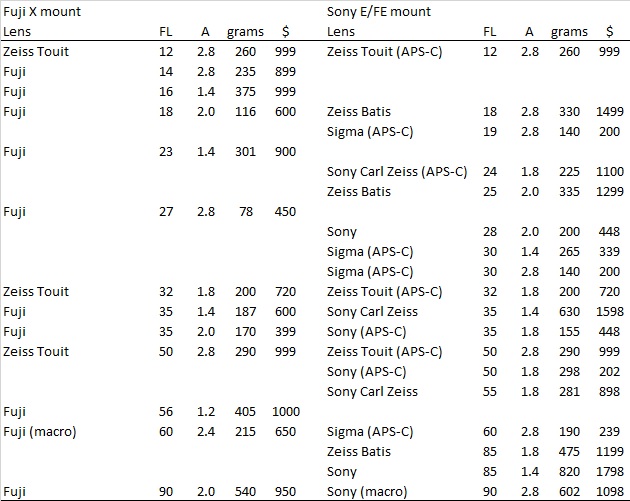
John likes to make and discuss very detailed lists. Most of his lists and contributions tend to be Sony centric, but I thought his recent subjective comparison of prime Fujifilm and Sony lenses was worth sharing. If you enjoy his comparison give John Clark Photography a look on Facebook.
“This is a comparison between the current Sony E/FE and Fuji X lens line-ups, considering only autofocus prime lenses (that means the Zeiss Loxia lenses are out) and assuming the camera is APS-C. This is not intended to be an inflammatory comparison but a fun (and interesting) ‘showdown’. If I have any facts wrong then please correct them.
1. Super Wide-Angle (10-17mm)
Both E and X have the Touit 12mm. Fuji has very credible 14mm and 16mm options. Sony only has a horrible 16mm pancake lens. Clear win to Fuji here.
2. Wide-Angle (18-20mm)
This is a battle between one Fuji and two E mount lenses:
– Fuji 18mm f/2 ($600)
– FE Zeiss Batis 18mm f/1.8 ($1,500)
– E Sigma 19mm f/2.8 ($200)
This kind of depends what budget you are on. The pros will want the Batis. Folks in the cheap seats will happily take the Sigma. The Fuji is a good mid-price option. Does the Fuji offer the same quality as the Batis for less than half the price? I have no idea. Those lucky enough to have it will say that the Batis is the cream of the crop. Others will claim that all you are paying for is the blue sticker.
Tough to call a winner here: draw.
3. Standard wide prime (24mm)
This is one of the blue-ribbon battles.
– Fuji 23mm f/1.4 ($900)
– Sony Carl Zeiss 24mm f/1.8 ($1,100)
The Fuji is faster and cheaper, but also a bit heavier (300 grams vs 225 grams). I guess this just comes down to if you think the Zeiss ‘pop’ (or whatever that mystical thing is) makes the difference. On the basis of the numbers, I’ve got to give a very slight edge to the Fuji here, although the near-macro capabilities of the Zeiss may tip it the other way for some shooters.
E mount also has the Zeiss Batis 25mm f/2 ($1,300) but for APS-C this is less relevant.
4. Standard mid prime (27-35mm)
There are a lot of lenses here, with Sony again having the most and least expensive. Both have the Zeiss Touit 32mm f/1.8.
In the 28mm range, there is a simple comparison:
– Fuji 27mm f/2.8 ($450)
– Sony 28mm f/2.0 ($450)
Not much to separate the lenses here.
At 35mm, the comparison is also pretty simple:
– Fuji 35mm f/1.4 ($600)
– Fuji 35mm f/2.0 ($400)
– Sony 35mm f/1.8 ($450)
– Sony Carl Zeiss 35mm f/1.4 ($1,600)
On this basis I would call a draw here, but Sony also has this:
– Sigma 30mm f/1.4 ($340)
In terms of specifications, it all looks pretty even. If you are simply after speed, then it comes downs to what you think of the Fuji 35 f/1.4 compared to the Zeiss 35 f/1.4 and the Sigma 30 f/1.4, which is partly a question of what you are prepared to spend.
I’m calling a draw here.
5. Nifty Fifty
Both systems have the Touit 50mm, but the real comparison here is between two great lenses:
– Fuji 56mm f/1.2 ($1000)
– Sony Carl Zeiss 55mm f/1.8 ($900)
The Fuji is significantly faster (and therefore heavier). The Sony is one of the most celebrated lenses of the last decade. I don’t think that there is much point picking a winner here: neither of these lenses represent a ‘weakness’ in their systems.
Where Sony does have an APS-C edge is here:
– E Sony 50mm f/1.8 ($300)
Given that this is a high quality lens for a relatively low price, for budget shooters the edge goes to Sony.
The side event here at a slightly longer focal length is interesting:
– Fuji 60mm f/2.4 macro ($650)
– E Sigma 60mm f/2.8 ($239)
The Fuji is slightly faster and has macro capabilities, but the Sigma is has nearly supernatural sharpness across the frame and is a lot cheaper. This has to be a draw.
6. 85-90mm
This is a comparison between one Fuji lens and three E/FE lenses:
– Fuji 90mm f/2 ($950)
– Sony 90mm f/2.8 OSS macro ($1,100)
– Zeiss Batis 85mm OSS f/1.8 ($1,200)
– Sony 85mm f/1.4 ($1,800)
Image quality is extremely high in all of these lenses. The Fuji is cheaper but not by a lot. At this focal length the lack of stabilization in the Fuji lens becomes an important issue, and on that basis I have to give the edge to the Sony 90mm (if you want macro) or the Batis (if you want speed) even before considering the faster and more expensive GM lens.
Conclusion
OK, so where does that leave us? At the very wide end, Fuji seems to have a clear edge. At the long end, the Sony system has the edge. In between, both systems have wonderful centrepiece lenses, with the Sony system having more budget options thanks to the Sigma lenses. There are no obvious weaknesses in either system from 18mm to 60mm. It is certainly not the case that Fuji’s lens range is vastly superior to the E/FE range.
If you simply need speed or a very narrow depth of field (or if you just think that faster=better) then Fuji offers that at a lower price than Sony (except for the Sigma 30mm f/1.4).
At around 24mm, 55mm and 90mm both systems have great lenses at similar prices.
At 18mm and 35mm the premium E/FE lenses are much more expensive than the Fuji X lenses. You can decide if they are worth it.”
